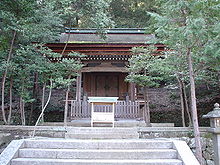Tsukuyomi-no-Mikoto
![]()
This article is about the kami Tsukuyomi. For the manga and anime series of the same name, see Tsukuyomi - Moon Phase.
Tsukuyomi no mikoto or also Tsukiyomi no mikoto, Tsuki no kami and Tsukiyumi no mikoto (jap. ツク(キ) ヨ(ユ)ミ (Kojiki: 月読命; Nihonshoki: 月読(夜見)尊、月弓尊)) is a male kami in Shintō mythology. He is the brother of Amaterasu and Susanoo, and was born from Izanagi's right eye when he ritually washed himself after going to the underworld. From his father, Tsukuyomi received the following order, "Your Highness shall rule the Night Ruled Land!"
His name most likely refers to the lunar calendar (tsuki means "moon" or also "month"; yomi could mean "underworld" as well as "night" or "darkness", but is commonly derived from the verb yomu (pre-modern "to count", today "to read")). Karl Florenz translates as "lunar night", "lunar nocturnal", "lunar counter" and "time counter".
The 12th century Ise-jingū scripture Yamato-bime-seiki shows him in an illustration as a man riding a horse. Within Shintō-Buddhist syncretism, he was also often equated with the Buddha Amida-nyorai.
Unlike his siblings, Tsukuyomi is hardly mentioned in the myths. The only exception is an episode in an alternative Nihonshoki version (I, 27), according to which he slew the food kami Ukemochi. According to all other texts, however, this was Susanoo. In this alternative version, the opposition of day and night is also justified by the fact that the sun kami Amaterasu was so disgusted by Tsukuyomi's deed that she proclaimed that she never wanted to see his face again.
Nevertheless, Tsukuyomi is venerated in many shrines. The most significant are the two Tsuki-yomi-no-miya (both bekkū) in the two main shrines of the Ise-jingū. In these he is worshipped along with his own ara-mitama. His shintai is a mirror.
As the main kami, Tsukuyomi finds veneration in the following shrines, among others: Toda-mura Gassan Shrine, Dewa-san-zan Gassan Shrine, Masuda-machi Gassan Shrine (Akita Prefecture), various Tsuki-yomi-jinja (Kizukuri-machi, Aomori Prefecture; Kushira-machi; Nishi-sakura-jima), Agetsu Shrine, Asuka-hachiman-sha, and Ōsasa Shrine.
He shares the honden at Imamiya-ebisu Shrine (Naniwa-ku, Osaka) with Waka-hiru-me, Koto-shiro-nushi, Amaterasu and Susanoo; at Matsue Rokusho Shrine with Amaterasu, Susanoo, Izanagi, Izanami and Ō-namuchi; at Takahara Shrine (Tochigi Prefecture) with Ō-namuchi, Koto-shiro-nushi and Saruda-hiko.
Other secondary shrines (named Tsuki-yomi-jinja) are dedicated to him at Nagata Shrine (Nagata-ku, Kōbe), Hirota Shrine (Nishinomiya), and Matsunoo Shrine (Kyōto), among others, and together with Amaterasu at Kumano Hongū-Taisha.

Tsukiyomi Jinja of the Matsunoo Shrine

Rare artwork with Tsukuyomi-no-Mikoto
_02.JPG)
Tsuki-yomi-no-miya in the Naikū of the Ise-jingū
Questions and Answers
Q: Who is Tsukuyomi in Japanese mythology?
A: Tsukuyomi is the god of the moon in Japanese mythology.
Q: Who are Tsukuyomi's siblings?
A: Tsukuyomi's siblings are Amaterasu, the goddess of the sun, and Susanoo, the god of the sea and storms.
Q: What is Tsukuyomi's full name?
A: Tsukuyomi's full name is Tsukuyomi-no-mikoto.
Q: What does Tsukuyomi represent in Japanese mythology?
A: Tsukuyomi represents the moon in Japanese mythology.
Q: Is Tsukuyomi male or female?
A: Tsukuyomi is male.
Q: How is Tsukuyomi related to Amaterasu in Japanese mythology?
A: Tsukuyomi is the brother of Amaterasu in Japanese mythology.
Q: What is Tsukuyomi's role in Japanese mythology?
A: Tsukuyomi's role in Japanese mythology is to govern the moon and its phases.
Search within the encyclopedia